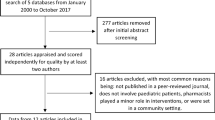Abstract
Objective To obtain community pharmacists’ opinions of their role in administering Pharmacy (S2) and Pharmacist Only (S3) Medicines in a medical emergency. These medicines can only be sold in a pharmacy and are not available for self-selection by patients. Whilst qualified pharmacy assistants can supply S2 medicines, pharmacists must be directly involved in the supply of S3 medicines. Setting Community pharmacies in South East Queensland, Australia. Method A survey of 151 Gold Coast and Toowoomba community pharmacists was conducted during October 2009. Main outcome measures Pharmacists were asked their opinions as to whether the administration of S2 and S3 medicines should fall within their scope of practice, whether they had administered S2 and S3 medicines in a medical emergency in the past and if clarification of this role was required. Results The study achieved a 30% (n = 45) response rate and demonstrated similar results regarding whether pharmacists should administer salbutamol (22/44), adrenaline (23/42), glyceryl trinitrate (22/43) and aspirin (18/36) in a medical emergency. The majority (36/43) believed that role clarification was required. Pharmacists were more likely to administer an S3 medicine in a medical emergency when they considered potential outcomes first, had no easy access to a doctor and the patient could not administer the medicine they carried with them themselves (40/45). Conclusion Community pharmacists have direct access to S2 and S3 medicines that could be required in the management of a variety of medical emergencies. This study demonstrates that some pharmacists have administered S2 and S3 medicines in an emergency situation. However, there are currently no clear guidelines for pharmacists when faced with a medical emergency other than to act within their professional competence. To promote patient safety through the appropriate use of S2 and S3 medicines in the event of a medical emergency, additional training of pharmacists on the administration of these readily accessible medicines is needed. Clarification of the role of pharmacists in an emergency situation is required.
Similar content being viewed by others
References
Benrimoj S, Frommer M. Community pharmacy in Australia. Aust Health Rev. 2004;28(2):238–46.
The Pharmacy Guild of Australia. About the guild. Available from: http://www.guild.org.au/The_Guild/tab-TheGuild/About_The_Guild/About+the+Guild.page? Accessed 27 June 2011.
Australian Government Department of Health and Ageing. Who we are and what we do. ACT: Commonwealth of Australia. Available from: http://www.tga.gov.au/about/tga-who-we-are.htm (2004). Accessed 27 June 2011.
Pharmaceutical Society of Australia. National competency standards framework for pharmacists in Australia 2010. ACT: Pharmaceutical Society of Australia. Available from: http://cpd.shpa.org.au/lib/pdf/Competency_standards_2010.pdf (2010). Accessed 27 June 2011.
Australian Government Department of Health and Ageing. National medicines policy. ACT: Commonwealth of Australia. Available from: http://www.health.gov.au/internet/main/publishing.nsf/Content/nmp-objectives-index.htm (1999). Accessed 27 June 2011.
Pharmaceutical Society of Australia. Submission by the pharmaceutical society of Australia to the Australian commission on safety and quality in health care draft discussion paper on patient safety in primary health care. ACT: Pharmaceutical Society of Australia. Available from: http://www.health.gov.au/internet/safety/publishing.nsf/Content/com-cont_PatientSafety-PHC-Submissions40-end/$File/50.pdf (2010). Accessed 27 June 2011.
Pharmaceutical Society of Australia. Issues paper on the future of pharmacy in Australia. Deakin: Pharmaceutical Society of Australia. Available from: http://www.psa.org.au/site.php?id=5855 (2010). Accessed 27 June 2011.
The Pharmacy Guild of Australia. The Roadmap: The strategic direction for community pharmacy. ACT: The Pharmacy Guild of Australia. Available from: http://www.guild.org.au/The_Guild/tab-Pharmacy_Services_and_Programs/The_Roadmap/The+Roadmap.page? (2010). Accessed 27 June 2011.
Hind C, Downie G. Vaccine administration in pharmacies–a Scottish success story. Pharm J. 2006;277:134–6.
American Pharmacists Association. Guidelines for pharmacy based immunization advocacy. Washington: American Pharmacists Association. Available from: http://www.pharmacist.com/AM/Template.cfm?Section=Pharmacist_Immunization_Center1&TEMPLATE=/CM/ContentDisplay.cfm&CONTENTID=23553 (2009). Accessed 27 June 2011.
Harrison T. What are the latest expectations for first aid and how can you meet them? Pharm J. 2010;284:455–7.
The Prescription Only Medicines (Human Use) Order 1997, UK [statute on the Internet]. Available from: http://www.legislation.gov.uk/uksi/1997/1830/article/7/made. Accessed 27 June 2011.
Health (Drugs and Poisons) Regulation 1996, QLD [statute on the Internet]. Available from: http://www.legislation.qld.gov.au/LEGISLTN/CURRENT/H/HealDrAPOR96.pdf. Accessed 27 June 2011.
Low J, Hattingh L, Forrester K. Australian pharmacy law and practice. NSW: Mosby Elsevier; 2010. p. 189–200.
Hattingh L, Forrester K, Smith N, Searle J. Pharmacy practice developments: the potential impact on pharmacists’ legal liability. J Law Med. 2007;14:397–402.
Pharmaceutical Society of Australia. Code of Professional Conduct. ACT: Pharmaceutical Society of Australia. Available from: http://www.psa.org.au/site.php?id=628 (1998). Accessed 27 June 2011.
Pharmaceutical Society of Australia. Professional practice standards—Version 4—June 2010. 4th ed. ACT: Pharmaceutical Society of Australia; 2010.
Pharmacy Board of Australia. Registration standards. Melbourne: pharmacy board of Australia. Available from: http://www.pharmacyboard.gov.au/Registration-Standards.aspx (2010). Accessed 27 June 2011.
Pharmacy Board of Australia. Code of conduct for registered health practitioners. Melbourne: Pharmacy Board of Australia. Available from: http://www.pharmacyboard.gov.au/Codes-and-Guidelines.aspx (2010). Accessed 27 June 2011.
Machado C, Barlows T, Marsh W, Coto-DePani Y, Dalin G. Pharmacists on the emergency cardiopulmonary resuscitation team: their responsibilities, training and attitudes. Hosp Pharm. 2003;38(1):40–9.
Commonwealth of Australia. A national health and hospitals network for Australia’s future delivering the reforms. ACT: Australian Government. Available from: http://www.yourhealth.gov.au/internet/yourHealth/publishing.nsf/Content/DeliveringTheReforms (2010). Accessed 27 June 2011.
Pace A, Flowers S, Hastings J. Arkansas community pharmacists’ opinions on providing immunizations. Journal of Pharmacy Practice. 2010;23(5):496–501.
Guild Insurance Limited. Matters of interest—Legal advice: administration of medicines in a medical emergency. Guild Insurance Ltd. August 2010.
Acknowledgments
We are grateful to the 45 community pharmacists who completed the questionnaire.
Funding
This work was supported by a Queensland Pharmacy Research Trust grant through the Pharmaceutical Society of Queensland.
Conflicts of Interest
None.
Author information
Authors and Affiliations
Corresponding author
Rights and permissions
About this article
Cite this article
McMillan, S.S., Hattingh, H.L. & King, M.A. Community pharmacists’ opinions of their role in administering non-prescription medicines in an emergency. Int J Clin Pharm 33, 800–805 (2011). https://doi.org/10.1007/s11096-011-9540-z
Received:
Accepted:
Published:
Issue Date:
DOI: https://doi.org/10.1007/s11096-011-9540-z




